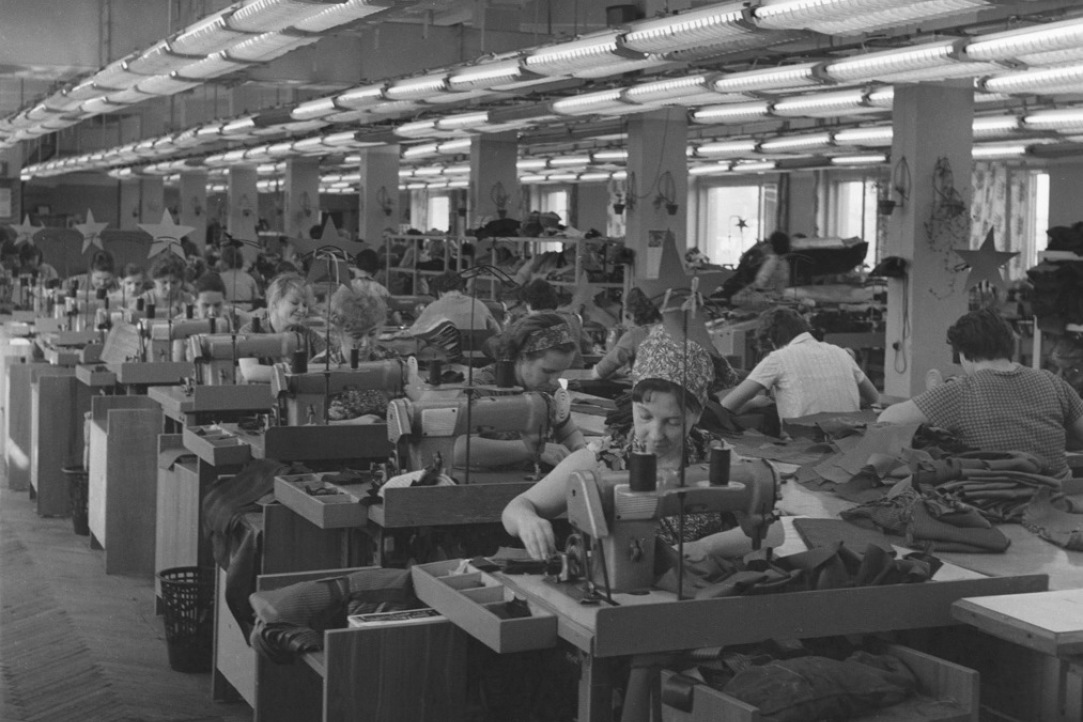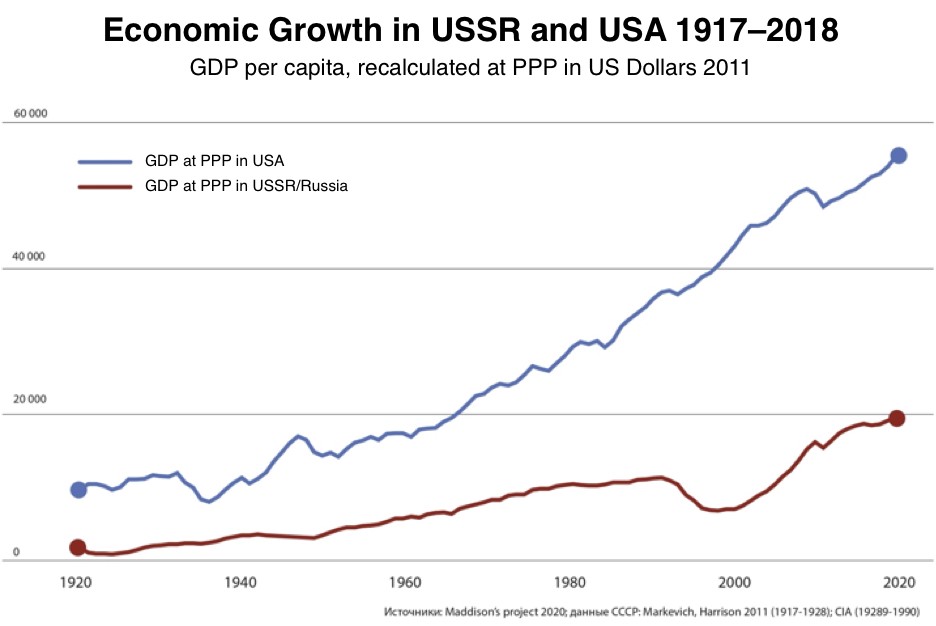Lost in Recalculation: How to Estimate the Scale of the Soviet Economy and Its Rate of Growth

Researchers trying to compare economic data of the USSR and capitalist countries face questions of the comprehensiveness, accessibility, and reliability of data on Soviet economic production and growth. At an online seminar hosted by the HSE University International Centre for the History and Sociology of World War II and its Consequences, Assistant Professor Ilya Voskoboynikov (Faculty of Economic Sciences, HSE University) presented an overview of available approaches to studying the absolute size of the Soviet economy and its growth rates.
Soviet economic growth and production rates remain an area of focus for contemporary researchers, insofar as they shed light on reasons behind for the deceleration of the Soviet national economy and the role economic factors played in the Soviet Union’s collapse. To study these problems and compare the economic indicators of the USSR and capitalist countries, sets of comparable data are needed.
World statistics now predominantly use the System of National Accounts (SNA), but in the case of the USSR, due to the lack of market prices and the difficulty of calculating defence expenditures, it does not always work. The official statistics of planned economies are based on the balance of national economy (BNE) and the concept of national product, which differ from the now familiar gross domestic product (GDP).
However, a significant part of government and defence services dropped out of the BNE, which, together with price regulation, creates unavoidable obstacles to measuring the GDP of planned economies, notes Ilya Voskoboynikov. Consequently, a comparison of the USSR’s national income and the United States’ GDP and their growth rates does not provide an accurate picture.

A serious problem is that comparing prescriptive prices with free market prices, together with the lack of data on real inflation, will yield incorrect results. To calculate prices, it is possible to use an adjusted factor value, taking into account indicators that were not taken into account in the USSR, such as profits and land rents, but these calculations contain certain assumptions.
If one studies a single product that can be measured in tons and rubles, then one looks at the physical volume of production. However, the economy consists of many products and services and the problem of index arises: how to measure everything using a single number and how to figure out the weight of each industry. Many indexes can be created, but the choice of base year and base prices creates an opportunity for manipulation.
Modern measurement tools have largely solved these problems, but they focus on big data and market prices, which creates problems with recalculation. The nominal value added has to be additionally calculated. That said, any estimates in industry sectors are more accurate than in services because market prices are unknown and the estimates are controversial. Therefore, data for coal and oil work better. The more complex the product, the worse it is reflected by the measurement tools.
Accounting for military expenditures and defence production and their impact on economic growth also pose significant problems. Alexey Ponomarenko, an economist and statistician who worked at Goskomstat (the Soviet predecessor of Rosstat, Russia’s Federal State Statistics Service) in the late 1980s and 1990s, studied these issues and solved the methodological problems of including military expenditures and military production in the system of national accounts. He described an estimate system based on partially published data.
However, in the Soviet economy, it is often difficult to separate military from non-military expenditures, particularly when it comes to the mobilisation of resources of the national economy to solve defence problems
There is still the question of how much the statistics allow us to observe the informal economy—the black market, underground industries, and a variety of ‘pushers’ (sellers, promoters) and intermediaries in informal barter deals — which according to various data amounted to about 12-12.5% of the economy. In the works of Alexey Ponomarenko the informal economy appears in the balance sheet of the national economy in the value of agricultural products and construction materials. If these data are taken into account, Ilya Voskoboynikov believes, the growth rates of the Soviet economy as a whole and the economy of the Russian Soviet Federative Socialist Republic may decrease.
In general, the Soviet GDP needs to be recalculated. Now economists and historians have more historical statistics, which were previously secret. In addition, data on the informal sector is now available, which may be very surprising.
The HSE researcher believes that the problem of recalculating economic growth of the 1930s will be the most difficult, because data from these years is more sketchy, and methods for calculating the gross national product were still under development. In the 1950s, methods had improved and intersectoral balances were introduced. Then the balances of the Soviet member states began to be developed and they began to participate more actively in the development of statistics.
According to Ilya Voskoboynikov, the impact of political repression on the economy and its growth in the USSR is also difficult to measure. He believes that the decline in labour supply weakened labour motivation and that working in a labour camp environment changed labour relations and reduced the efficiency of the economy.
At present, there are By 1960 the Soviet economy was about half the size of the American economy. Until the mid-1970s, the Soviet economy grew at a faster rate than the U.S. economy. Then it slowed.no scientific works that facilitate a full comparison of production, labour productivity, and their growth rates between the USSR and the leading capitalist countries for the entire period. Ilya Voskoboynikov noted that the growth rates of the USSR and U.S. economies were generally comparable, but they differed significantly in different periods. In particular, they were very high during the NEP (New Economic Policy) and period of industrialisation: the Soviet Union managed to narrow the gap with the United States during the Great Depression of 1929-1933, but the national economy was subjected to heavy destruction during World War II.
By 1960 the Soviet economy was about half the size of the American economy. Until the mid-1970s, the Soviet economy grew at a faster rate than the U.S. economy. Then it slowed
Ilya Voskoboynikov concluded that he could not predict what the results of recalculating data on production in the Soviet economy and its growth would be. ‘We are [like the proverbial soldier] trying to make soup out of a hatchet and get ingredients that we can actually eat. We all understand: the existing numbers are not good enough for us, but the approach from different sides of the economy is complicated. It will take a lot of data and time,’ he said.
Professor Oleg Budnitskii, Director of the HSE University International Centre for the History and Sociology of World War II and Its Consequences, described his impressions of his recent work: ‘I had no idea of the scale of railway theft during the war. People were amazingly resourceful, stealing extreme amounts during the war and after. I don't know how it can be counted economically, but the scale was impressive,’ he concluded.
The moderator of the seminar, Professor Oleg Khlevniuk, Chief Research Fellow of the Centre, noted that scientists should hardly expect quick results in the recalculation—it is not only about market and non-market prices, but also about the fundamental difference between the two systems. He stressed that historians need to continue cooperating with economists in the study of modern history.
See also:
Scarcity Trauma: Why Russia in the 1990s Was not Nostalgic about Soviet Life
In 2001, ten years after the launch of reforms in Russia, 54% of Russians believed the main achievement of the reforms was the availability of consumer goods, rather than freedom of speech or the possibility of travelling abroad. A decade later, public attitudes had not changed, and the availability of goods on store shelves was still perceived as the number one priority. The massive trauma caused by scarcity was particularly strong. How it was addressed and in what way it influenced public attitudes after the USSR collapse is examined in a study by HSE professor Oleg Khlevnyuk.
Socialism on the Steppe: How Soviet Specialists Changed Life in Mongolia
‘We tried to give them a bright future.’ These are the words of engineers, construction workers, geologists, doctors and other specialists from the former Soviet republic regarding the years they spent in Mongolia. Those Soviet-era specialists are still united by the memory of trying to build something on such a grand scale and then seeing the whole project collapse. More than 100 members of that community agreed to be interviewed in-depth by political scientist Alexei Mikhalev. Here, he shares information from their collective memory with IQ.HSE.
'People are Key to the Future Economy'
Maxim Oreshkin, Minister of Economic Development of the Russian Federation and HSE graduate highlighted the key values of the future economy, while speaking at the panel discussion ‘Global Trends: Challenges and Windows of Opportunity’, which was held as part of HSE’s programme at the XIX World Festival of Youth and Students.
Transnational Connections in History or Why Study the USSR?
On March 11, Seth Bernstein gave a presentation — ‘Burying the Alliance: Interment, Repatriation and the Politics of the Sacred in Occupied Germany’ — at the scholarly seminar of the HSE International Center for the History and Sociology of World War II and Its Consequences where he works as a postdoctoral research fellow.
Annual Symposium of the Association of German and Russian Economists ‘Innovation: the Way towards Continued Growth? German-Russian Experience Exchange’
The annual symposium of the Association of German and Russian Economists (dialog e.V.), which is open to all who are interested, will take place in Moscow on May 23-25. The dialog e.V. Association has held the symposium for 15 years in a row and is in its own way a platform for creating and developing the Russian-German contact network in the fields of economics, politics, management and education.
‘Our Interest Is More than just Economics’
On September 29th the first lecture in the cycle of meetings of top-managers of the largest in Europe gas company E.ON Ruhrgas AG with the university students took place at the HSE. Steffen Bruendel, Head of Cultural and Academic Affairs at the E.ON Ruhrgas Corporate Office, and Hans-Peter Floren, Member of the Board of Management, E.ON Ruhrgas AG, told us about this lecture course.
Germany And Russia: Innovation Development
On July 11-th, the three day Russian-German seminar ‘S&T and Innovation Development’ started at HSE. The organizers of the event are the Institute for Statistical studies and Economics of knowledge (ISSEK, HSE) and the Fraunhofer Institute for systems and innovation research (ISI, Germany).


